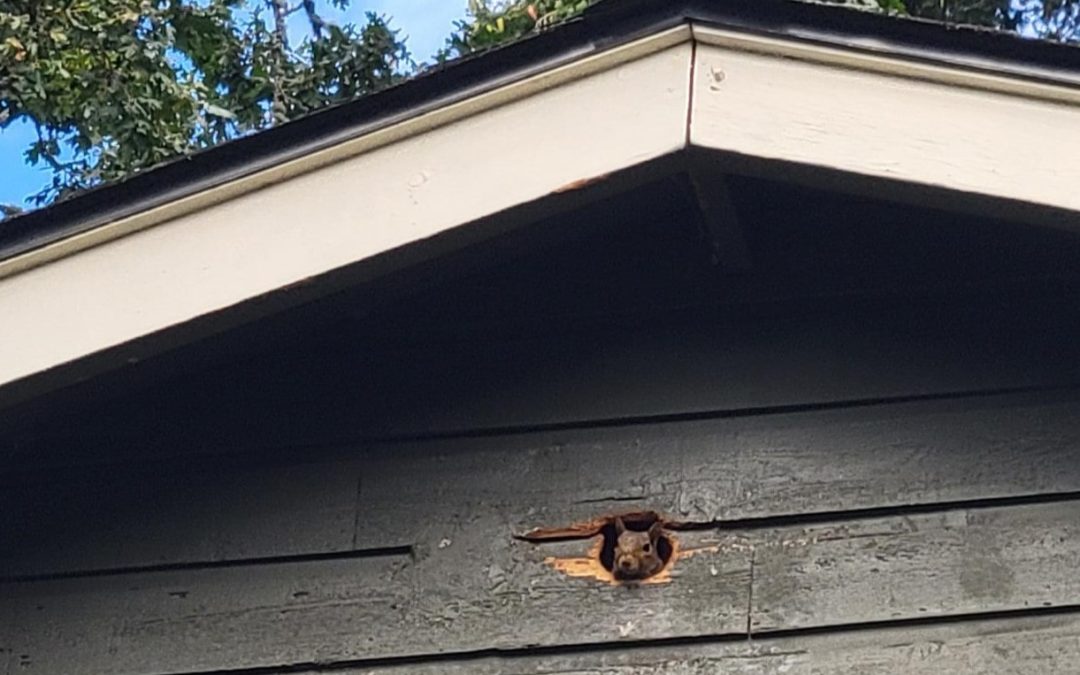A Guide to Identifying and Solving the Problem
Hearing scratching, scurrying, or gnawing sounds coming from your walls is unsettling. You’re sitting down to relax, and suddenly, there’s a faint but persistent noise. What could it be? While it might feel like a mystery, those sounds could very well be caused by pests that have made their way into your home.
From rodents and birds to insects, identifying the source of the noise is key to resolving the issue and keeping your home pest-free. Let’s break down the possible culprits, what signs to look for, and what steps to take next.
Key Takeaways
- Rule out mechanical noises first.
- Scratching or scurrying sounds in walls are often caused by rodents, bats, birds, or insects.
- Determining the pest involves considering the time of day, type of sound, and other clues.
- Professional help is often the best way to eliminate pests and prevent future issues.
Could It Be Your Home’s Mechanical Systems?
Not all strange sounds in your walls are caused by pests. Sometimes, your home’s mechanical systems—water lines, waste pipes, or HVAC units—can produce unexpected noises that mimic scratching or scurrying.
Before you sound the alarm about potential critters, take a moment to rule out household systems as the source. Humming, clicking, or tapping can sometimes originate from water lines, heaters, or vents rather than rodents or wildlife.
If the noise never changes location, doesn’t intensify when you tap on the wall, or consistently follows an action like flushing a toilet, running the laundry, or the heater kicking on, it’s likely a mechanical issue rather than a pest problem.
Identifying the true cause not only saves time and effort but also ensures you focus on the right solution—whether that’s calling a plumber or, if necessary, addressing a genuine pest infestation.
Why Are Pests in Your Walls?
Pests seek out wall voids for a few key reasons:
- Shelter: Walls provide a safe, warm, and undisturbed environment for nesting.
- Food: Easy access to pantry goods, crumbs, or even other pests can attract them.
- Entry Points: Cracks, gaps, and damaged screens give pests a way in.
How to Confirm the Issue
Listen Closely: Pay attention to when the noises occur. Are they more pronounced at night (common with rodents), during the day (often squirrels or birds), or at dawn or dusk (a possible sign of bats)? Also note whether the sound changes if you tap the wall or shift furniture. These observations can help narrow down which pest is causing the noise.
Inspect Your Home: Take a walk around the interior and exterior of your home to look for telltale signs of pest activity:
-
- Droppings: Rodents leave small, pellet-like droppings, while bird or bat droppings may look different in size and consistency.
- Chew Marks or Damage: Look for gnaw marks on baseboards, siding, vents, or wiring. Structural gaps or holes could be entry points.
- Rub Marks: Rodents often leave greasy smudges along walls and beams where their fur brushes.
- Other Clues: Keep an eye out for footprints, fur, or small tunnels in insulation, which can indicate an active nesting site.
Check for Nests: If you can safely access your attic, crawlspace, or other suspected areas, look for nesting materials such as shredded paper, leaves, twigs, or insulation that might be piled up. Birds may leave more obvious nests with sticks or grass, while rodents, bats, or insects might hide their nests in less conspicuous spots. Spotting these materials or any noticeable activity in one area can confirm that you have an active infestation rather than a one-time visitor.
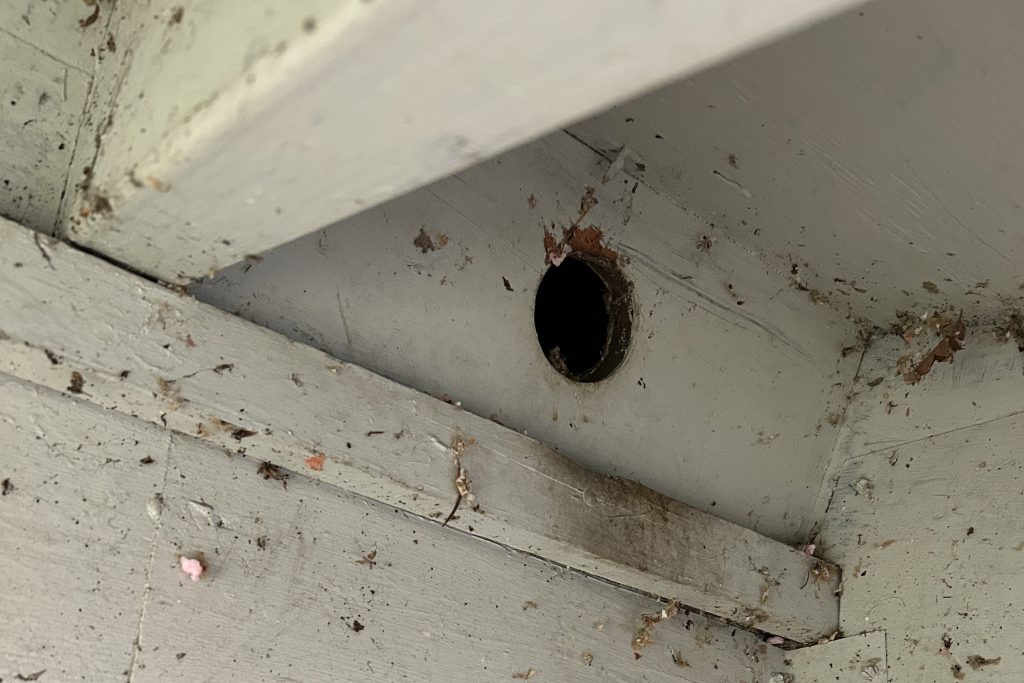
Rodent Highway: This oil buildup around a hole in this soffit reveals a well-used entry point for pests.
Common Culprits Behind Scratching Sounds
Rodents (Mice and Rats)
These guys, they’re #1 by a long shot. Rodents are a leading cause of scratching noises in walls and typically the first thing that people think of when they start hearing something.. They’re small, resourceful, and can squeeze through incredibly tiny openings to find shelter inside your home.
- When You’ll Hear Them: Nights, when they’re most active.
- Other Signs: Droppings, gnawed materials, and greasy rub marks along baseboards or walls.
- Why They’re a Problem: Beyond the noise, rodents can damage insulation, chew wiring (posing fire risks), and contaminate your living space.
Squirrels
Squirrels typically enter homes seeking nesting sites, often through roof vents or gaps near the eaves. Their movements are more erratic and heavier than rodents.
- When You’ll Hear Them: Daytime, especially early morning and late afternoon.
- Other Signs: Chewed entry points and nests made of leaves or insulation.
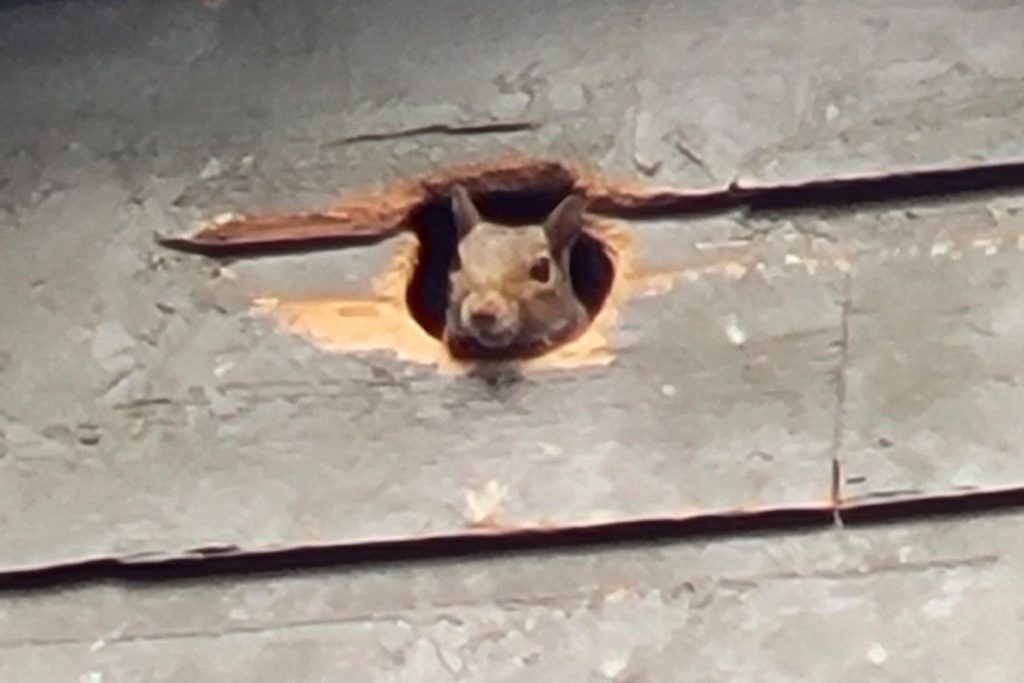
Up close and personal: A gray squirrel peers out from a hole it created in the home’s wood siding.
Birds
Birds might get stuck or intentionally nest in your walls, chimneys, or vents. Their fluttering and chirping are telltale signs.
- When You’ll Hear Them: Daytime.
- Other Signs: Nesting materials near vents or droppings around your home’s exterior.
Bats
Bats, unlike the vampires they are associated with, don’t need to be invited in to enter your home, and they can be quite sneaky about it. They are quieter than rodents or birds but can still create scratching or fluttering sounds. They’re more likely to roost in attics or wall voids.
- When You’ll Hear Them: Dusk or dawn as they leave or return to their roost. Take a look outside during these times to try and see them emerging!
- Other Signs: Guano (bat droppings) near entry points and a musky odor.
Insects (Termites, Carpenter Ants, and Beetles)
Certain insects can also cause faint scratching sounds, especially as they tunnel through wood. Termites and carpenter ants are particularly concerning because they can weaken structural components over time.
- When You’ll Hear Them: Mostly at night when it’s quiet.
- Other Signs: Piles of frass (wood droppings) and hollow-sounding wood.
(Note: Yellow jackets can also nest in walls and will be audible during the day. There may be a buzzing sound as well as a faint scratching crunching sound, but before you start banging on the wall you should know that the crunching sound is them chewing on the walls to make more room for their nest. They will chew away at the drywall until there is nothing but the thin coat of paint left between them and your bedroom. Talk about nightmare fuel!)
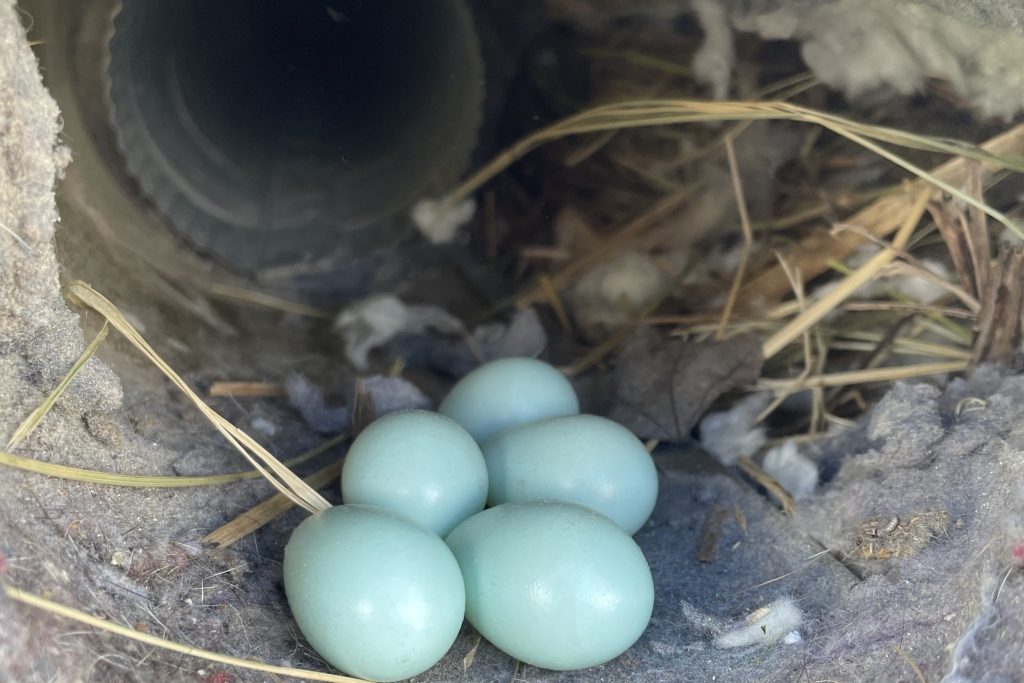
Unexpected Nesting: European starlings have claimed this oven vent duct for their eggs and nest.
How to Solve the Problem
Before you do anything, make sure you know the rules and regulations specific to the animal causing the issue. For instance, many birds are protected by the Migratory Bird Treaty Act and cannot be disturbed until they have left the nesting area naturally.
- Identify and Remove the Pests: Each pest requires a different removal approach:
-
- Rodents: Snap traps or exclusion techniques work best. Avoid poisons indoors to prevent dead rodents in hard-to-reach places.
- Squirrels and Birds: Professional trapping or exclusion is often necessary. Carefully remove any nesting material and repair entry points after the animals are gone.
- Bats: Special exclusion devices allow bats to leave but not re-enter. Bats are protected, so they should be controlled with care and within legal guidelines.
- Insects: Consult with a professional who can provide a targeted treatment approach to the area at hand.
- Clean and Repair: After pests are removed:
-
- Sanitize areas to eliminate bacteria, odors, and pheromones that attract other pests.
- Seal gaps, cracks, and entry points to prevent re-entry.
- Consult a Professional: Dealing with pests in walls can be tricky. Professional pest control technicians have the tools and expertise to:
-
- Accurately identify the pest.
- Safely remove or treat the infestation.
- Implement long-term prevention strategies.
Click HERE for more information on rodent and wildlife services offered by Good Earth!
Preventing Future Infestations
- Seal Entry Points: Regularly inspect and repair cracks, gaps, and holes around your home.
- Store Food Properly: Keep pantry goods in airtight containers and clean up crumbs promptly.
- Eliminate Water Sources: Fix leaks and reduce moisture in crawl spaces or basements.
- Maintain Landscaping: Trim trees and shrubs away from the house to reduce access points.
- Schedule Regular Inspections: Professional inspections can catch potential problems early.
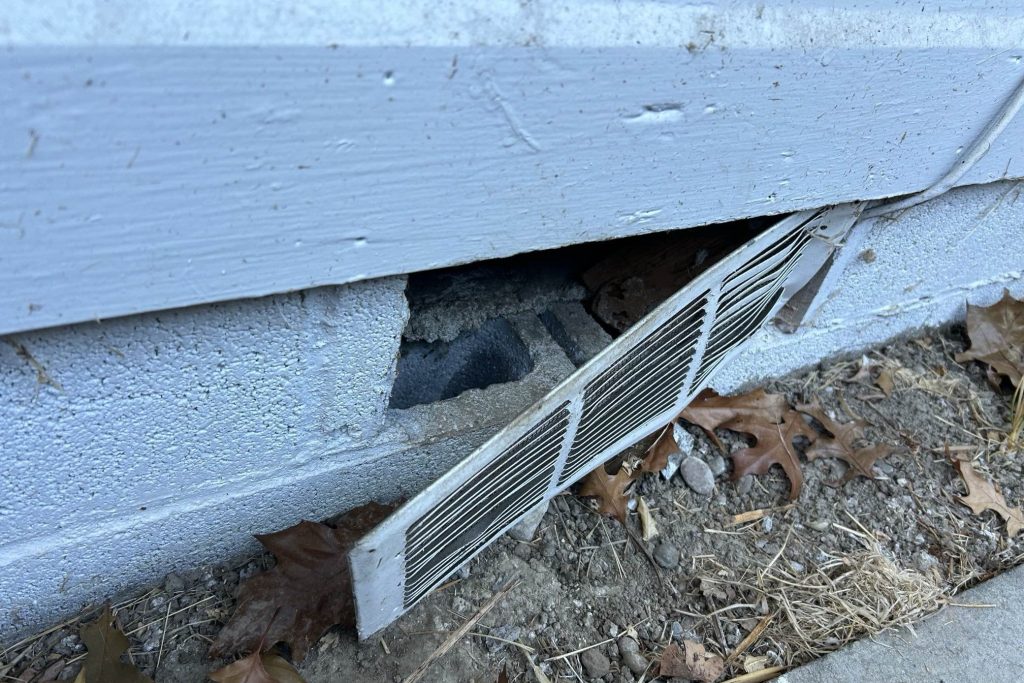
Damaged Vent Alert: A broken foundation vent can offer rodents and other pests an easy way into your home.
Final Thoughts
Scratching sounds in your walls can be more than just a nuisance—they’re often a sign of a larger pest issue. By identifying the source, taking action to remove the pests, and implementing preventative measures, you can keep your home quiet and pest-free.
If you’re hearing unexplained noises or need help tackling a pest problem, Good Earth Pest Company is here to help. Reach out to our team of experts to protect your home and regain your peace of mind.

